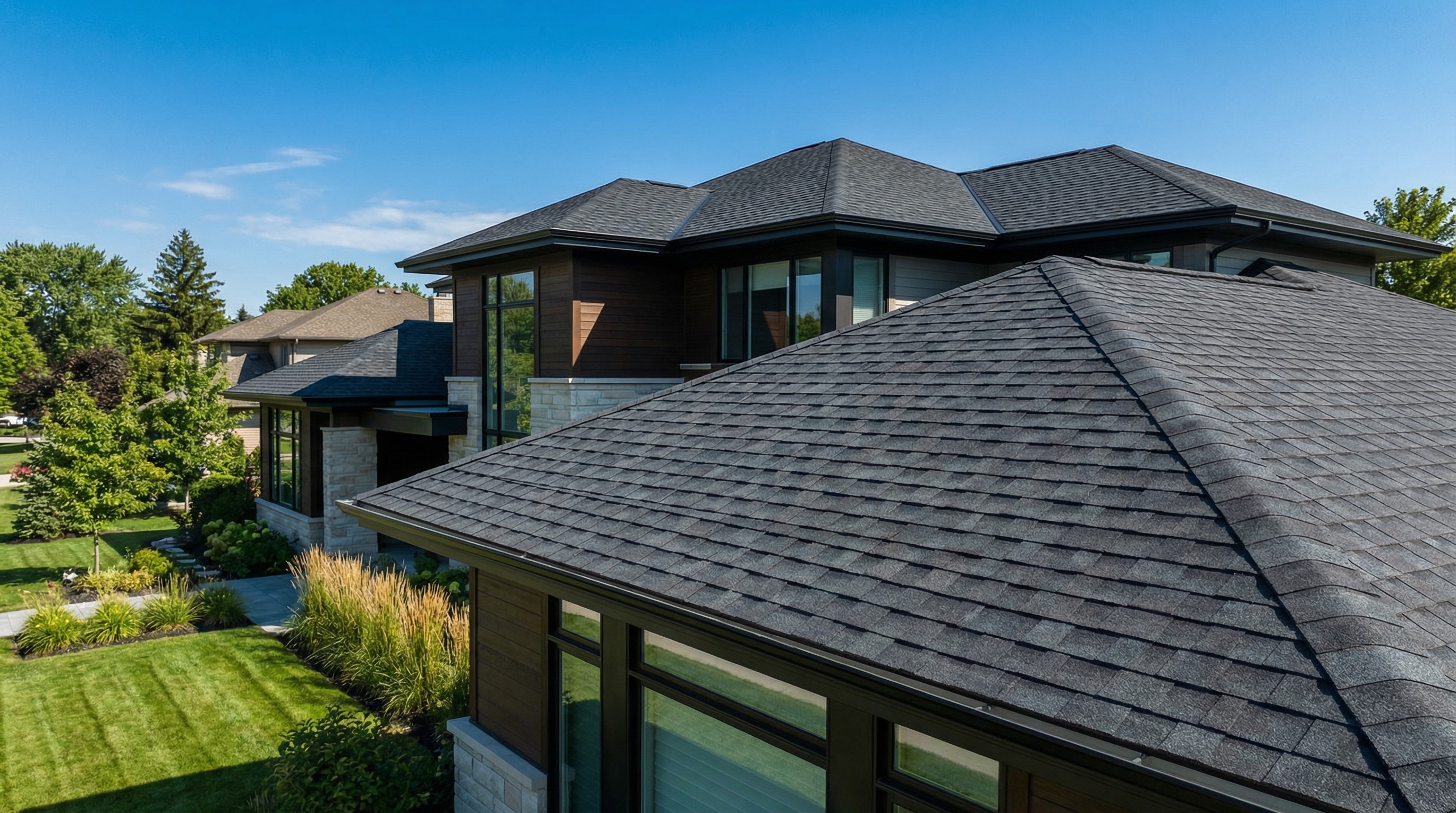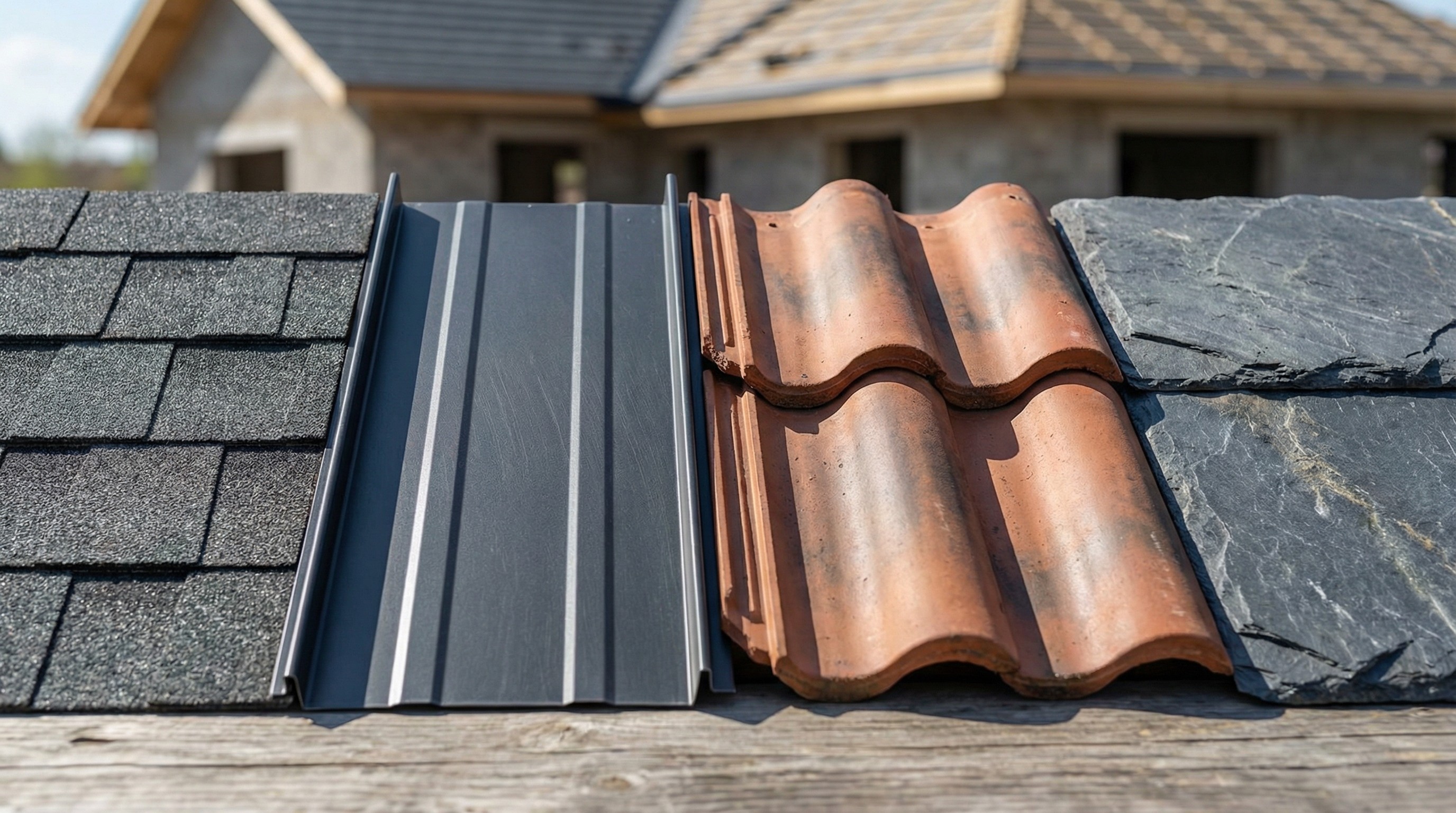As roofing experts, we see homeowners exploring tile options more frequently-and for good reason. Clay, concrete, slate, metal, composite, and solar tiles each offer distinct advantages depending on your budget, climate, and aesthetic goals.
With so many tile options available, we've created this comprehensive guide to help you compare materials, costs, and lifespans with confidence.
What Are Roof Tiles
Roof tiles are individual pieces of roofing material that overlap to create a protective layer over your home. The most common types include clay, concrete, slate, metal, composite, and solar tiles. Each one offers a different combination of durability, appearance, and price.
Tiles differ from standard asphalt shingles in a few important ways. They're thicker, heavier, and typically last much longer. Roofers install them one piece at a time, either interlocking or overlapping so water runs off instead of seeping through.
Why Choose a Tile Roof Over Asphalt Shingles
Tile roofs cost more upfront than asphalt shingles. However, the longer lifespan often makes tile a better investment over time. Here's what draws homeowners to tile:
Longevity: Most tile roofs last 50 years or more, compared to 15 to 30 years for asphalt shingles
Durability: Tiles hold up better against fire, wind, and impact damage
Curb appeal: A tile roof adds a distinctive look that can boost your home's resale value
Energy efficiency: Many tile materials reflect heat, which helps keep your home cooler
That said, tile isn't the right fit for every home or budget. The weight alone can be a limiting factor, and installation costs run higher because the work is more labor-intensive.

Common Roof Tile Types
Choosing a tile comes down to your budget, your home's style, and your local climate. Here's what you need to know about each option to determine the best fit for your home and budget.
Clay Roof Tiles
Clay tiles are made from natural terracotta that's shaped and fired at high temperatures. They have a warm, earthy color and a classic look you'll often see on Mediterranean or Spanish-style homes.
Clay tiles excel in durability, often lasting 50 to 100 years with proper installation. Clay also handles heat well, making it a solid choice for warm, dry climates. On the downside, clay tiles are heavy and can crack if something heavy falls on them.

Concrete Roof Tiles
Concrete tiles are popular because of their versatility-manufacturers can mold and color them to mimic slate, wood shakes, or clay.
Concrete costs less than natural stone or clay while still offering good durability. It's a practical middle-ground option for homeowners who want the tile look without paying premium prices. Like clay, concrete is heavy, so your roof structure may need to be evaluated before installation.
Slate Roof Tiles
Slate is natural stone that's quarried and split into thin, flat pieces. It's considered the premium choice for tile roofing because of its elegance and exceptional lifespan.
A well-installed slate roof can last over 100 years. However, slate requires a significant investment in both material costs and structural considerations due to its substantial weight. You'll typically find slate on upscale or historic homes where the investment makes sense.
Metal Roof Tiles
Metal tiles are made from steel, aluminum, or copper. They're lightweight compared to stone or concrete, and they come in a variety of styles and finishes.
Metal performs well in harsh weather. It resists high winds, fire, and hail better than most other materials. The look tends to suit contemporary or minimalist homes, though some metal tiles are designed to mimic traditional materials like slate or wood.

Composite Roof Tiles
Composite tiles are made from a blend of materials like polymer, sand, or recycled plastic. The goal is to replicate the appearance of natural slate or wood without the weight or cost.
Composite offers a good balance between aesthetics and affordability. Durability varies depending on the manufacturer, so it's worth asking about warranty coverage before making a decision.
Cedar Shake Roof Tiles
Cedar shakes are natural wood tiles with a rustic, handcrafted appearance. They're a popular choice for Craftsman or cottage-style homes.
While cedar offers beautiful natural aesthetics, it requires regular maintenance to prevent moisture damage, insect issues, and fire risk.
Fiber Cement Roof Tiles
Fiber cement tiles are made from cement mixed with cellulose fibers. They can replicate the look of wood or slate while offering better fire resistance.
Fiber cement is durable and low-maintenance. It's a practical choice for homeowners who want a natural appearance without the ongoing upkeep that real wood requires.
Solar Roof Tiles
Solar tiles integrate photovoltaic cells directly into the roofing material. They generate electricity while protecting your home, combining two functions in one product.
To determine if solar tiles are right for your home, consider your current energy costs, roof orientation, and available tax incentives in your area.
Copper Roof Tiles
Copper is a premium metal option that develops a distinctive green patina as it ages. It's extremely long-lasting and often used for accents or high-end homes.
For homeowners seeking a premium, distinctive option with exceptional longevity, copper tiles offer unmatched durability and develop a beautiful patina over time.
Tile Type | Material | Best Home Style | Relative Cost |
|---|---|---|---|
Clay | Natural terracotta | Mediterranean, Spanish | Medium-High |
Concrete | Sand, cement, water | Versatile | Medium |
Slate | Natural stone | Historic, upscale | Premium |
Metal | Steel, aluminum, copper | Modern, contemporary | Medium-High |
Composite | Polymer blends | Any style | Medium |
Cedar shake | Natural wood | Craftsman, cottage | Medium-High |
Fiber cement | Cement and fibers | Traditional | Medium |
Solar | Photovoltaic cells | Modern, eco-focused | Premium |
Copper | Copper metal | Upscale, accents | Premium |
How to Choose the Right Roof Tile Material
Once you know what's available, the next step is narrowing down what works for your home. Three factors tend to matter most: climate, architectural style, and local regulations.
Climate and Weather Considerations
Your local weather plays a big role in which tiles perform best.
Hot climates: Clay and concrete reflect heat well and help keep homes cooler
Rainy areas: Slate and metal shed water effectively
High-wind zones: Tiles with interlocking designs offer better wind resistance
Hail-prone regions: Impact-resistant materials like metal or composite hold up better
Matching your tile to your climate helps avoid problems down the road.
Matching Tiles to Your Home's Architectural Style
Some tiles naturally complement certain home styles. Clay barrel tiles suit Mediterranean architecture. Slate works well on historic properties. Metal and composite tiles fit contemporary designs.
You don't have to match perfectly, but choosing a tile that complements your home's character usually looks better. It can also help with resale value if you decide to sell later.
Local Building Codes and HOA Requirements
Before committing to a tile type, check your local regulations. Some areas restrict certain materials due to fire codes or weight limits. Homeowners associations often have approved color or style lists.
Checking with your local building department before selecting materials ensures compliance and prevents costly delays during installation.
Roof Tile Costs Compared to Other Roofing Materials
Tile roofing costs more upfront than asphalt shingles. The longer lifespan often offsets the initial investment, but the higher price tag is still a factor for most homeowners.
Installation is also more labor-intensive with tile, which adds to the total cost. Here's a general breakdown by price tier:
Lower cost tiles: Concrete, fiber cement, composite
Mid-range tiles: Clay, metal, cedar shake
Premium tiles: Slate, solar, copper
Getting multiple quotes from vetted contractors helps you understand fair pricing in...
How Long Do Roofing Tiles Last
Tile roofs generally outlast other roofing materials by a wide margin. Slate and clay can last 100 years or more with proper care. Concrete and metal typically offer 50 to 75 years of service.
Composite and fiber cement tiles fall in the middle, usually lasting 30 to 50 years. Cedar shake has a shorter lifespan unless it's well-maintained.
Proper installation matters just as much as the material itself. Even the best tiles won't perform well if they're installed incorrectly.
Tile Roof Weight and Structural Requirements
Roof tiles are heavier than asphalt shingles. Concrete and slate are the heaviest options, while metal and composite are lighter alternatives that can mimic heavier materials.
Some homes may need a structural assessment before tile installation. If you're considering a heavy tile like slate or concrete, ask your roofer whether your roof deck and framing can support the weight. Reinforcing the structure adds cost, but it's better to know upfront.






